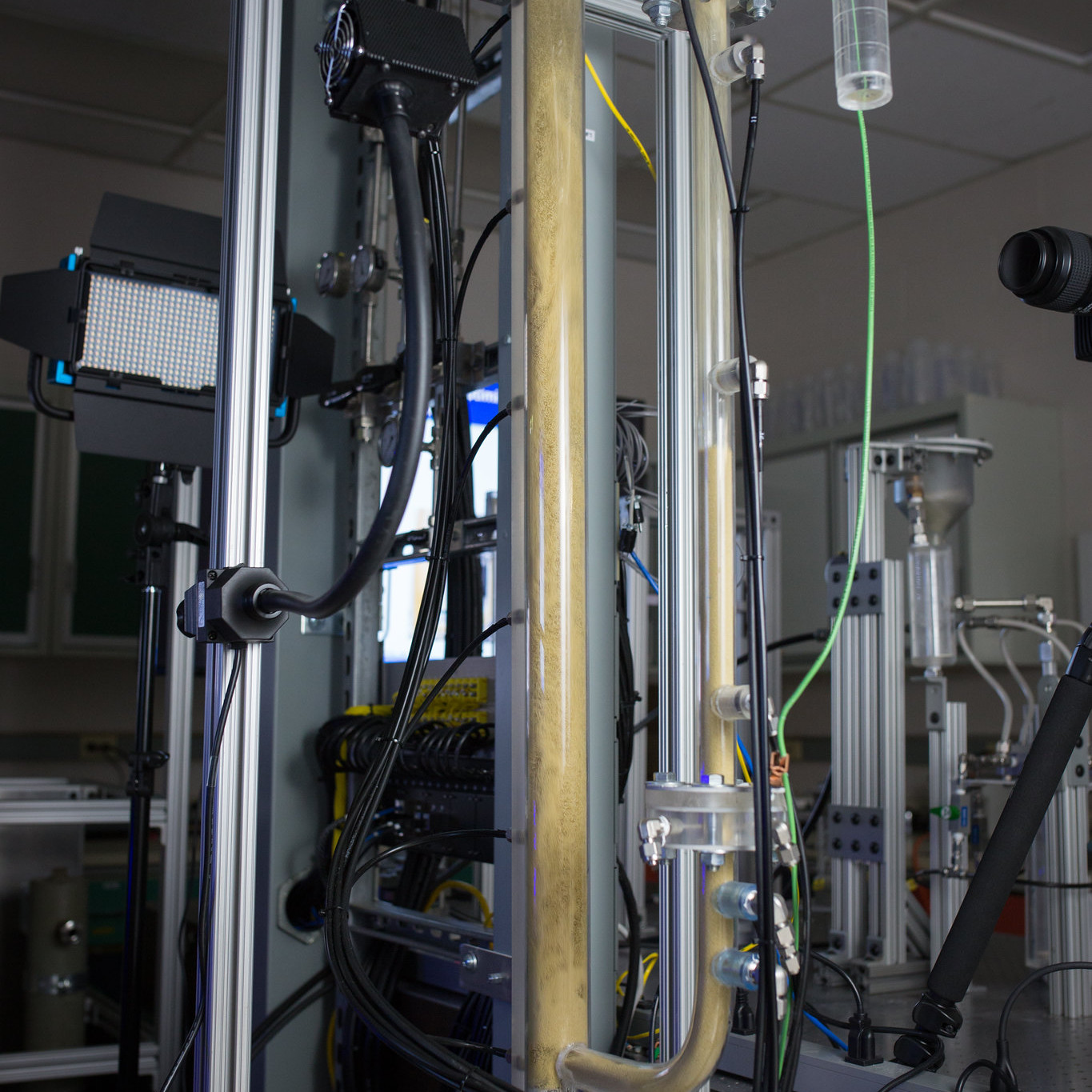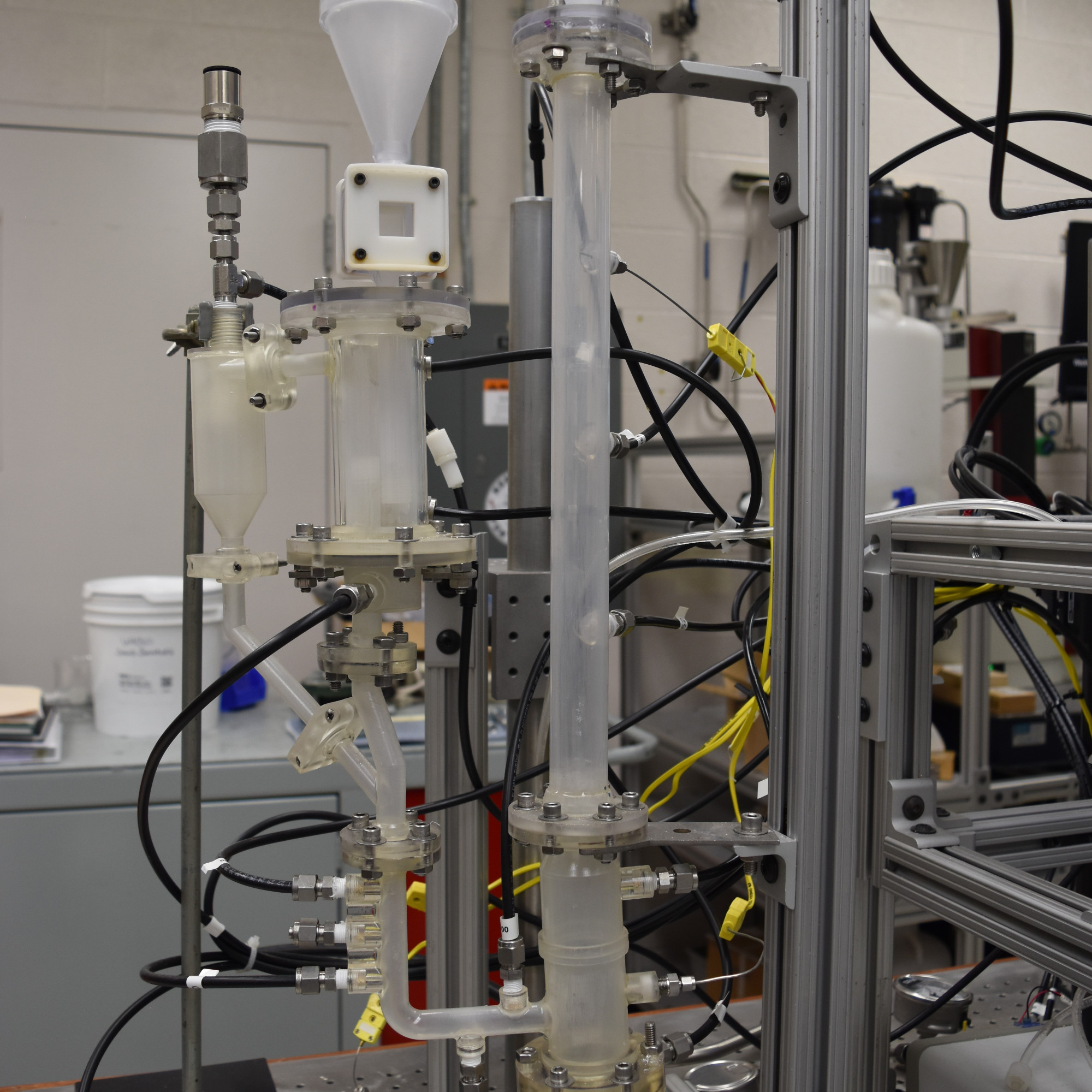Multiphase Flow Experiment Program
The primary mission of the multiphase flow analysis laboratory is to support the computational fluid dynamics (CFD) modeling efforts at NETL by generating high quality data sets for model development and validation.
To carry out this mission, the laboratory utilizes a range of small-scale test rigs that are designed and fabricated in-house to meet the specifications set by the modeling team. Historically, these small-scale test rigs have included circulating fluidized beds (CFB’s), fluidization test beds used for determination of minimum fluidization velocities, bubbling fluidized beds, chemical looping CFB’s, packed beds, as well as pulsed fluidization and test rigs that are customized for novel diagnostic measurements such as addition of sight windows for inline laser holography measurements of solids circulation rates
Laboratory-scale cold-flow experiments are performed for small-scale, low temperature test units to generate well-characterized, high quality multiphase flow data. The experimental rigs cover a wide range of fixed, moving, bubbling, turbulent, and transport fluidized bed. The materials of construction are selected to allow for visualization of solids and fluid phases and high-resolution measurements using a variety of flow diagnostic techniques such as Laser Doppler Velocimetry (LDV) and Particle Image Velocimetry (PIV), Particle Tracking Velocimetry (PTV), and In-line laser holography. These methods, combined with the standard temperature, transient pressure, and gas composition measurements provide a comprehensive data set for model development and validation. These experiments also provide platforms for development of novel measurement techniques.
Periodically, the MFS program conducts formal Multiphase Flow challenge problems.
Bubbling Fluidized Beds
Similar in design to the Fluidization Test Beds, the Bubbling Fluidized Beds are transparent cast acrylic fluidization columns with inner diameters of 2.5-, 4- and 6-inches. These fluidized beds have been used to study a wide range of fluidization phenomena, including riser scaling effects using glass beads, particle segregation and mixing, and co-fluidization of biomass materials, plastics, and silica sands.
Mini-Circulating Fluidized Bed (mini-CFB)
The mini-CFB is a small, bench-scale transparent circulating fluidized bed used as a test bed for various flow visualization and measurement techniques, such as measuring solids circulation rates using high-speed particle imaging velocimetry (HS-PIV). The riser is 2in. ID, the standpipe is 1in ID. Overall height is 48in.
The unit is a valuable tool to help demonstrate some of the underlying gas-solid flow dynamics and structures.
Mini-Chemical Looping Reactor (mini-CLR)
The mini-chemical looping reactor (mini-clr) is a small bench-scale chemical looping test bed for sorbent-based carbon capture. During operation, a mixture of nitrogen (N2) and carbon dioxide (CO2) gas in introduced into a bed of fine zeolite particles in the adsorber region of the bed. The zeolite separates the CO2 from the N2 and travels through the riser and primary cyclone into the regenerator region, where additional N2 is injected into the bed and the CO2 is released. Finally, the zeolite is returned from the regenerator to the adsorber via the standpipe, while the captured CO2 and N2 exit the system through the secondary cyclone.
Data obtained from this experimental unit was used to validate a reacting flow MFIX-DEM model developed at NETL.
Flow Control and Data Acquisition
Gas flow control and data acquisition for the Multiphase flow laboratory are provided via instrumentation carts consisting of National Instruments data acquisition hardware and computers running Labview software for data collection and control. Flow control is provided via a wide selection of Alicat Scientific MCR-series mass flow controllers with flow capacities ranging from 0-20 slpm to 0-2000 slpm. Low speed (1Hz) and high speed (100Hz) differential pressure transducers are available for real-time measurement of operating pressures within the test vessels. Temperature and relative humidity measurements via thermocouples and relative humidity sensors are also available. Flow temperature and humidity control are also available.





